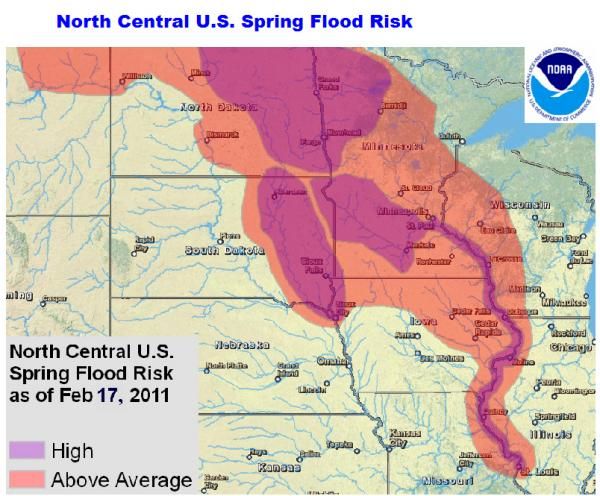
Major Spring Flooding Likely for Large Regions of U.S.

A large swath of the country should be on the lookout for floods this spring, according a regional forecast released by the National Weather Service (NWS) today (Feb. 18).
From northeastern Montana through western Wisconsin, following the Mississippi River south to St. Louis, NWS flood experts are forecasting moderate to major flooding in their initial spring flood outlook for this high-risk region. The entire national spring flood outlook will be released on March 17.
For the third consecutive year, forecasters predict moderate to major flooding along the Red River of the North, which forms the state line between eastern North Dakota and northwest Minnesota and includes the Souris River Basin and the Devils Lake and Stump Lake drainages in North Dakota.
If the current forecast holds, the main stem Mississippi River is at risk for moderate to major flooding from its headwaters in St. Paul, Minn., all the way to St. Louis.
The flood forecasters point to several reasons for the anticipated floods. The ground in much of the north-central United States is frozen, saturated with water, and snow-covered . That means water won't have anywhere to sink in and instead will run off into the waterways. Forecasts for much of the region continue to call for persistent below-normal temperatures and above-normal precipitation for February, with an expectation for the snowpack to grow.
In March and April, as temperatures rise and the snow melts, frozen ground and saturated soil will enhance runoff, causing streams and rivers to swell. The timing and the rate the snow melts and any rain that falls during snowmelt will contribute to the magnitude and extent of flooding.
"Excessive precipitation, mainly in the form of snow, coupled with continuously frigid temperatures has yielded a thick snowpack in much of the upper Midwest. We expect significant flooding when this snow begins to melt," said Lynn Maximuk, central region director of the National Weather Service. Residents in high-risk areas should closely monitor river forecasts and warnings, and prepare now for flooding, Maximuk said.
Sign up for the Live Science daily newsletter now
Get the world’s most fascinating discoveries delivered straight to your inbox.











